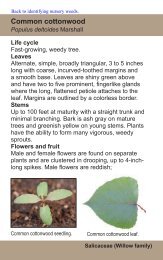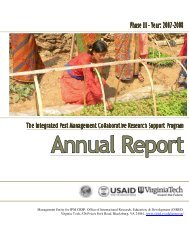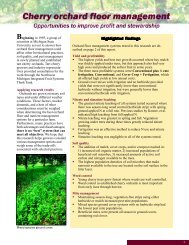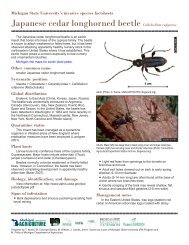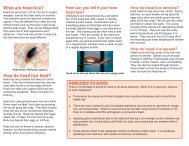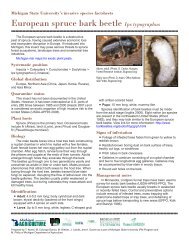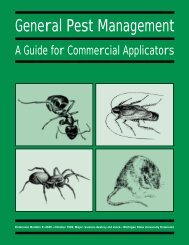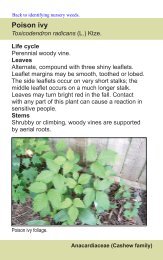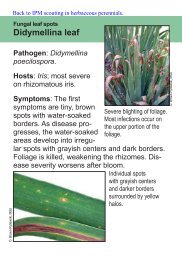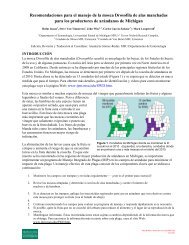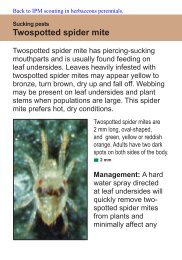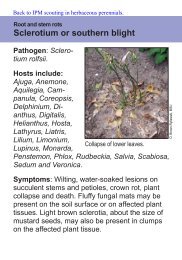Whole Manual - Michigan State University: Integrated Pest ...
Whole Manual - Michigan State University: Integrated Pest ...
Whole Manual - Michigan State University: Integrated Pest ...
Create successful ePaper yourself
Turn your PDF publications into a flip-book with our unique Google optimized e-Paper software.
MANAGEMENT<br />
Avoidance: Once established, root-knot nematodes are<br />
virtually impossible to eradicate. Therefore, attempts<br />
should be made to keep sites clean of northern root-knot<br />
nematode for as long as possible. This is accomplished<br />
primarily by using nematode-free transplants and by not<br />
contaminating fields with northern root-knot nematodeinfested<br />
soil.<br />
Population Reduction<br />
CULTURAL CONTROLS: Sites with histories of rootknot<br />
nematode problems should be kept out of vegetable<br />
production for a period of two to four years. NRKN nonhost<br />
crops such as corn or small grains should be grown<br />
to reduce population densities. Weed control is important<br />
because many weeds serve as hosts for the northern rootknot<br />
nematode.<br />
GENETIC CONTROLS: Some varieties of vegetables are<br />
reported to be resistant or tolerant to root-knot nematodes.<br />
CHEMICAL CONTROLS: Sites should be routinely sampled<br />
for plant-parasitic nematodes before vegetables are<br />
planted, especially those extremely susceptible to NRKN.<br />
If nematode population densities are recovered at damage<br />
threshold levels, use of a nematicide may be advised.<br />
Lesion Nematode (Pratylenchus penetrans)<br />
HOST PLANTS: Virtually all species of cultivated<br />
plants.<br />
BIOLOGY: Lesion nematodes overwinter as juveniles<br />
and adults within roots or in soil. These nematodes penetrate<br />
young roots. Once inside the root, they migrate<br />
between and through cells, often killing them.<br />
Lesion nematode females lay eggs singly in root tissue<br />
or in soil. Females typically produce fewer than 100 eggs.<br />
Life cycles can be completed in three to four weeks,<br />
depending on soil temperatures. They can complete multiple<br />
generations per growing season.<br />
SYMPTOMS: Aboveground symptoms are virtually the<br />
same as those produced by the NRKN. Penetration of<br />
roots by lesion nematodes results in very small lesions.<br />
These wounds create a point of entry for other soil<br />
pathogens, such as the fungi Verticillium, Cylindrocarpon,<br />
Rhizoctonia, Colletotrichum, and possibly others.<br />
Lesion nematode-infected plants typically have<br />
reduced root volumes and weights. Feeding and migration<br />
by these organisms kills cells. Feeder roots are usually<br />
destroyed.<br />
MANAGEMENT<br />
Avoidance: Plant lesion nematode-free transplants.<br />
Population Reduction<br />
CULTURAL CONTROLS: Lesion nematodes feed on virtually<br />
all species of cultivated plants, so they are difficult<br />
to manage with rotation. Asparagus is a very poor host.<br />
Fields with histories of lesion nematode problems should<br />
Lesion nematodes in roots.<br />
be kept fallow before planting. Maintaining a clean fallow<br />
is important because many weeds serve as hosts.<br />
Utilizing sorghum or sudax as a rotational crop may help<br />
to reduce population densities of lesion nematode.<br />
CHEMICAL CONTROLS: See the section on nematicides.<br />
Cyst Nematode (Heterodera spp.)<br />
HOST PLANTS: Four species of cyst nematodes feed on<br />
vegetable crops in <strong>Michigan</strong>. The carrot cyst nematode,<br />
Heterodera carotae, has carrot as its only host. The soybean<br />
cyst nematode, H. glycines, feeds on green beans and<br />
peas. The sugar beet cyst nematode, H. schachtii, feeds on<br />
a variety of vegetables, including beets, broccoli, cauliflower,<br />
cabbage, Brussels sprouts, turnips and spinach.<br />
The clover cyst nematode, H. trifolii, is reported to feed on<br />
some vegetables but is not regarded as a serious pest of<br />
these crops in <strong>Michigan</strong>.<br />
BIOLOGY: Cyst nematodes overwinter as eggs within<br />
cysts in the soil. Cysts are the dead remains of female<br />
nematodes. They are lemon-shaped and about the size of<br />
a pinhead. Eggs hatch and second-stage juveniles emerge<br />
from the cysts, migrate through the soil, and enter roots<br />
to feed. They swell as they grow, eventually becoming<br />
large enough that they rupture the root and are exposed<br />
to the soil. If cyst nematode-infected roots are examined<br />
closely after gently removing the soil, these females can<br />
be seen with the naked eye. They are white or yellow,<br />
Vegetable Crop <strong>Pest</strong> Management 83<br />
Chapter 8



